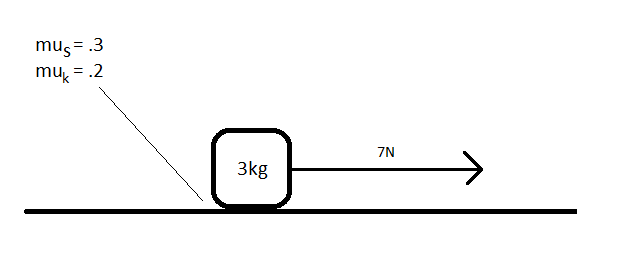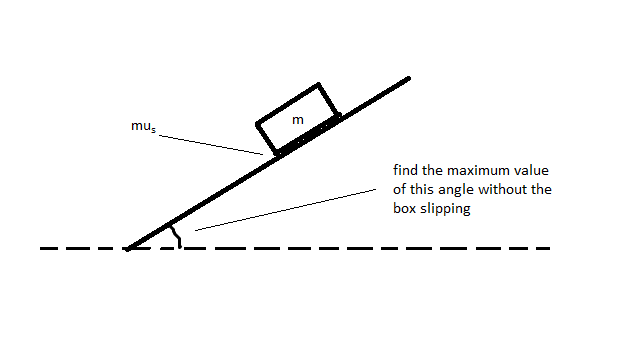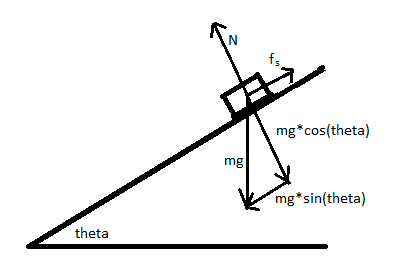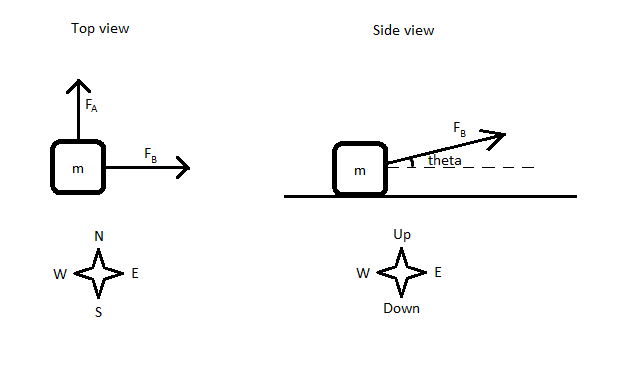Static Friction: Difference between revisions
| Line 107: | Line 107: | ||
== See also == | == See also == | ||
[[Friction]] | *[[Friction]] | ||
[[Point Particle Systems]] | *[[Rollii | ||
[[Real Systems] | *[[Point Particle Systems]] | ||
*[[Real Systems]] | |||
===External links=== | ===External links=== | ||
* | *[https://en.wikipedia.org/wiki/Friction#Static_friction The Wikipedia page on friction] | ||
*[http://hyperphysics.phy-astr.gsu.edu/hbase/frict2.html An explanation of static friction with some diagrams] | |||
*[http://www.animations.physics.unsw.edu.au/jw/weight_and_friction.htm A couple of animations] | |||
==References== | ==References== | ||
Revision as of 15:33, 5 July 2019
This page defines and describes static friction. Some of the information presented on this page is also present on the Friction page.
The Main Idea
Static friction is a type of Friction between two touching objects that are not moving with respect to each other at their point of contact. When two objects touch each other and there is no sliding between their surfaces of contact, they exert static friction forces on each other. The static friction force acting on each object opposes any force that would cause it to slide relative to the other object. For example, consider a heavy dresser at rest on the floor. If a child pushes against the side of the dresser in an attempt to slide it, that exerts a force on the dresser, but the ground would exert on it an equal and opposite static friction force that balances the force exerted by the child, so the dresser stays at rest. The static friction force can take on whatever direction and magnitude necessary to balance an external net force that threatens to cause sliding motion between two surfaces. However, the magnitude of the static friction force is limited by a maximum value. If the external force becomes strong enough, the static friction force can be overcome and the surfaces can begin to slide, at which point the friction between the objects becomes Kinetic Friction. For example, now consider an adult pushing against the same heavy dresser. The adult can exert a stronger force than the child, and if it exceeds the maximum possible static friction force, the dresser can be set into motion and slid across the floor.
Rolling Friction
Friction is responsible for the rolling of round objects. When this rolling happens without slipping, the friction is static. Consider a wheel rolling without slipping across the ground. At a glance, it may seem like the friction between the wheel and the ground should be kinetic because the center of the wheel moves relative to the ground. However, to determine the type of friction acting between the wheel and the ground, one must look at the point of contact between them. The point of contact between the wheel and the ground occurs on the edge of the wheel on its lowest point, which is not moving relative to the ground. The point of contact between the wheel and the ground constantly changes but does not slide.
For an object rolling at a constant speed, the magnitude of the static friction force is 0 because there are no forces threatening to cause the wheel to slip. For an accelerating rolling object, however, such as a disk rolling down a ramp, the friction force has a nonzero magnitude to prevent the disk from slipping. Without this friction force, a disk placed on a ramp would simply slide down without rotating. It is important to ask oneself whether the static friction force acting on an accelerating rolling object is capable of doing work. The answer depends on whether the rolling object is modeled as a Point Particle System or a Real System. If the system is treated as a point particle, the static friction force is treated as though it acts on the particle's center of mass. It is therefore exerted over a distance and does work, affecting the object's total kinetic energy. If the system is treated as a real object, the static friction force is recognized as acting on the object's stationary edge, and therefore does no work. For the real system, the object's total kinetic energy would be the same even if the static friction force at its edge were absent. The only difference is that now some of its kinetic energy is rotational rather than translational. Point particles cannot have rotational kinetic energy, so the static friction force is treated as though it does work to account for the difference in total kinetic energy.
A Mathematical Model
As described above, the magnitude of the static friction force ([math]\displaystyle{ F_s }[/math]) between two objects is bounded by a maximum value. This maximum static friction force is given by
[math]\displaystyle{ F_{s, max} = \mu_s * N }[/math]
where [math]\displaystyle{ \mu_s }[/math] is the coefficient of static friction of the objects and [math]\displaystyle{ N }[/math] is the normal force between the objects. [math]\displaystyle{ \mu_s }[/math] is a property of the materials of the surfaces in contact and is usually less than 1. [math]\displaystyle{ \mu_s }[/math] has no units because it is a ratio of one force to another.
Often for problems involving rolling friction, the static friction never reaches its maximum allowed by the formula above. In fact, you may not be told the value the coefficient of static friction, only that it is high enough to prevent the object from slipping. For such problems, you may be asked to find some unknown quantity, such as the acceleration of a disk rolling down a ramp, which may seem difficult if the value of the friction force is unknown. To solve such a problem, a system of equations should be devised, where one equation relates the friction force to the translational acceleration of the disk and another equation relates the friction force to the rotational acceleration of the disk. For more information, see Rolling Motion.
A Computational Model
This is a VPython simulation of a box held in place by static friction. A steadily increasing external force, shown by the green arrow, is balanced by an equal and opposite static friction force, until the magnitude of the external force exceeds [math]\displaystyle{ \mu_s * N }[/math]. At this time, the box begins to move and the friction becomes kinetic.
Click "View this program" on the top left corner to view the VPython code.
Examples
Be sure to show all steps in your solution and include diagrams whenever possible
1. (Simple)
A box sits at rest on a table. The box has a mass of 3kg, the coefficient of static friction between the box and the table is .3, and the coefficient of kinetic friction between the table is .2. A horizontal external force of 7N is applied to the box. Does the box remain at rest?
Solution:
The maximum static friction force [math]\displaystyle{ F_{s, max} }[/math] is given by the equation
[math]\displaystyle{ F_{s, max} = \mu_s * N }[/math]
Since the table is a horizontal surface and the box is not accelerating vertically, the normal force must be equal in magnitude to the block's weight, or [math]\displaystyle{ 3 * 9.8 = 29.4 }[/math] N.
[math]\displaystyle{ F_{s, max} = .3 * 29.4 = 8.82 }[/math]N
The external force is only 7 N, and the static friction force can be up to 8.82N, so the static friction force is able to balance the external force and keep the block at rest.
2. (Middling)
A box of mass [math]\displaystyle{ m }[/math] sits on an inclined plane. The coefficient of static friction between the box and the inclined plane is [math]\displaystyle{ \mu_s }[/math]. What is the steepest the inclined plane can be without the box slipping down the ramp?
Solution:
Let us call the angle that the box makes with the horizontal [math]\displaystyle{ \theta }[/math]. This makes the gravitational force down the ramp [math]\displaystyle{ mg\sin\theta }[/math] and the normal force between the box and the ramp [math]\displaystyle{ mg\cos\theta }[/math].
When the ramp is as steep as it can be without slipping, the gravitational force down the ramp is balanced by the maximum possible static friction force up the ramp, so the following equation is true:
[math]\displaystyle{ mg\sin\theta = F_{s, max} }[/math]
[math]\displaystyle{ mg\sin\theta = \mu_s * N }[/math]
[math]\displaystyle{ mg\sin\theta = \mu_s * mg\cos\theta }[/math]
dividing both sides by [math]\displaystyle{ mg\cos\theta }[/math] yields
[math]\displaystyle{ \tan\theta = \mu_s }[/math]
[math]\displaystyle{ \theta = \tan^{-1}\mu_s }[/math]
3. (Difficult)
A crate of mass [math]\displaystyle{ m }[/math] lies at rest on a flat horizontal surface. The coefficient of static friction between it and the ground is [math]\displaystyle{ \mu_s }[/math]. Two people are pushing on the crate, applying forces to it. Person A applies a horizontal force in the northerly direction with a magnitude of [math]\displaystyle{ F_A }[/math]. Person B applies a force in the easterly direction with a magnitude of [math]\displaystyle{ F_B }[/math]. However, this force is not perfectly horizontal; it is directed with an angle [math]\displaystyle{ \theta }[/math] above the horizontal. In terms of the other variables given, what is the minimum magnitude of [math]\displaystyle{ F_A }[/math] that would cause the crate to move?
Solution:
To get the crate to move, the net horizontal force must exceed the maximum possible static friction force.
The net horizontal force is given by
[math]\displaystyle{ F_{net,horizontal} = \sqrt{F_A^2 + (F_B\cos\theta)^2} }[/math] by Pythagorean theorem
The maximum static friction force is given by
[math]\displaystyle{ F_{s,max} = \mu_s * N }[/math]
[math]\displaystyle{ F_{s,max} = \mu_s * mg - F_B\sin\theta }[/math] since the vertical component of person B's force helps lift the box
Let us set [math]\displaystyle{ F_{net,horizontal} }[/math] equal to [math]\displaystyle{ F_{s,max} }[/math] since that is the minimum value of [math]\displaystyle{ F_{net,horizontal} }[/math] to get the crate to move
[math]\displaystyle{ \sqrt{F_A^2 + (F_B\cos\theta)^2} = \mu_s * mg - F_B\sin\theta }[/math]
[math]\displaystyle{ F_A = \sqrt{(\mu_s * mg - F_B\sin\theta)^2 - (F_B\cos\theta)^2} }[/math]
Connectedness
See also
- Friction
- [[Rollii
- Point Particle Systems
- Real Systems
External links
- The Wikipedia page on friction
- An explanation of static friction with some diagrams
- A couple of animations
References
The book we used in class was a reference utilized in the creation of this page:
Matter and Interactions 4th edition. Full Citation: Chabay, Ruth W., and Bruce A. Sherwood. Matter and Interactions. Hoboken, NJ: Wiley, 2011. Print.



